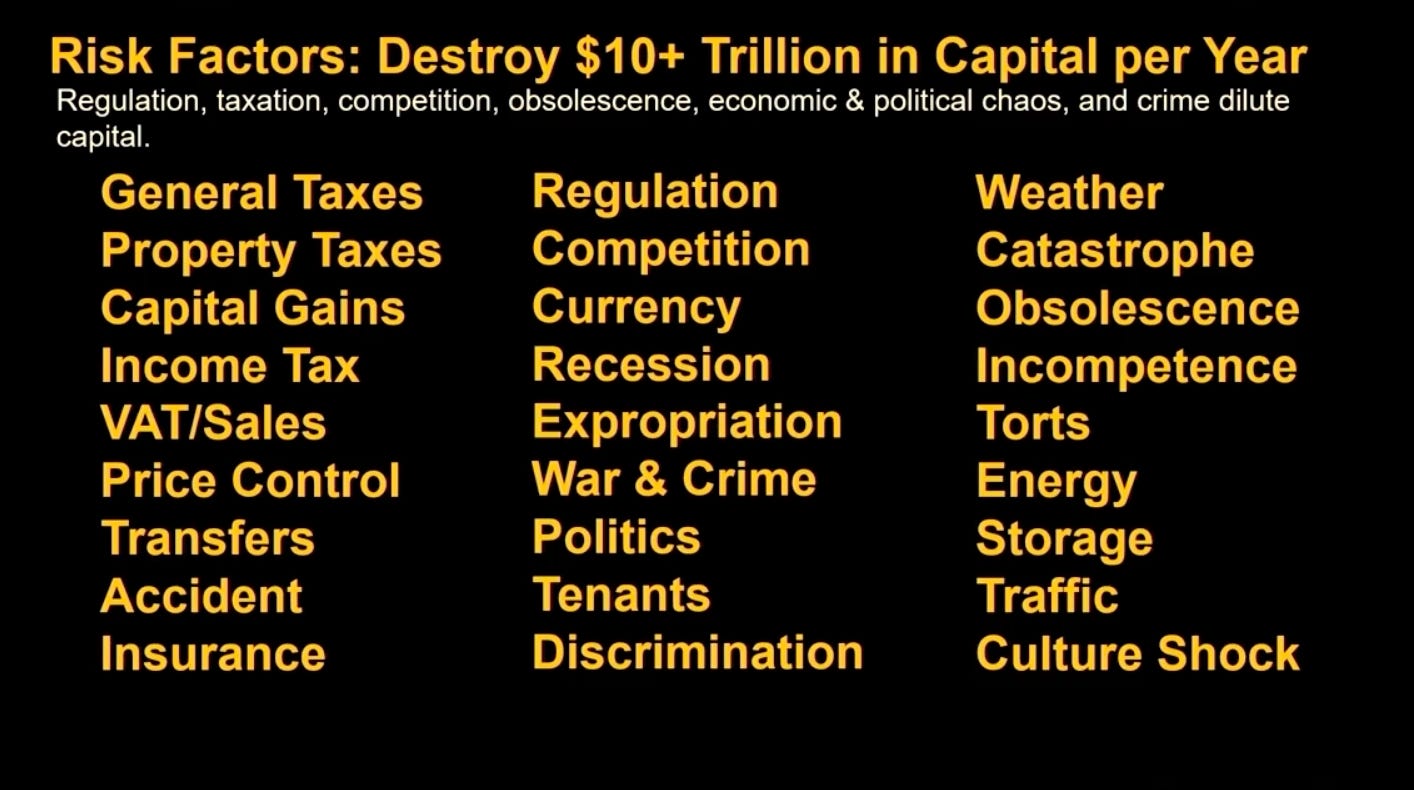#4 Bitcoin as Corporate Lifeboat
How to Keep the Missing Ten Percent
The image below lists the usual suspects, taxes, regulation, expropriation, war, inflation, incompetence, and reminds us that together they erase more than $10 trillion of corporate capital every single year.
Set that against a global GDP of roughly $106 trillion and you grasp the scale: about 9–10 % of the planet’s annual output is siphoned away before it can compound.
I do not need to invent a horror story to illustrate it; Cyprus did the work for us in 2013 when a surprise “haircut” confiscated up to 47 % of bank deposits above €100 000. Scores of perfectly solvent businesses woke up to find their working capital frozen or halved.
Owning the private keys to your treasury turns that type of event into headline noise rather than an existential threat. The State may issue decrees; it cannot sign your transactions.
Why Bitcoin Stanches the Bleeding
Our goal at Sobtree is not to dodge lawful taxes, but to shield productive capital from structural erosion. Bitcoin gives four tangible advantages:
Fixed monetary policy: no printer can dilute your reserve.
Low confiscation risk: keys reside outside banking rails and registries.
Instant, permissionless portability: capital crosses borders in minutes, neutralising capital controls.
Political neutrality: an open protocol does not discriminate by nationality, industry or ideology.
Depending on the nature of the business, Bitcoin can even shift from a passive holding to an “active business asset”. Two routes we are analysing with tax counsel:
• Collateral-backed operations, using BTC to secure credit that finances core revenue streams.
• Software mining, running non-industrial validation nodes that earn transaction fees and integrate directly with company software.
In both cases the asset becomes integral to production, not merely an investment, and may qualify for more favourable accounting and depreciation rules.
The exact treatment varies by jurisdiction, but the principle is clear: tie Bitcoin to the engine room, not the glove compartment.
The Virtuous Loop Already Turning
Companies convert a slice of treasury into BTC.
Governments feel a thinner tax base and respond with larger deficits and more money creation.
Extra fiat chases a capped supply of 21 million coins, pushing the price higher.
Rising price validates the strategy and lures the next wave of adopters.
Over 830 000 BTC already sit on corporate balance sheets, close to 4 % of the eventual supply, and institutional holdings grew about 50 % in 2024 alone. Many of those positions were built quietly; public announcements arrive only when the stack is unmovable. Firms that wait for unanimous approval will arrive last and pay the highest ticket.
Designing a Treasury That Keeps the Ten Percent
After months of modelling scenarios, we believe an antifragile policy should include:
Loan-to-value ceilings between 15 % and 25 % on any BTC-backed credit, so an 60 % draw-down cannot trigger liquidation.
2-of-3 multi-sig custody split across Spain, Switzerland and Gibraltar, three friendlier jurisdictions, limiting single-country confiscation risk.
Specialised crime-insurance coverage on keys and procedures; premiums hover around 0.4 % of insured value.
Transparent bookkeeping: every on-chain move reconciled inside the ERP and filed for the auditor; clarity beats secrecy.
Automated fiat-to-BTC bridge: excess operating cash sweeps daily via an OTC desk straight into the vault, no human hesitation, no weekend gaps.
We are not prescribing; we are documenting what the numbers suggest a prudent firm could do to seal the leaks highlighted in that yellow list.
A Quick Numerical Contrast
Assume a digital-services firm clears €1 million after tax on €1 million revenue. With a conventional euro-only treasury:
The Coming Wave of Quiet Adopters
Debt-soaked governments plus ageing banking infrastructure equal more currency creation, not less. Agile SMEs and mid-caps will surf that tide, while risk-averse giants debate press releases. My bet is that the next blue-chip to shock Wall Street will not announce a mining farm; it will silently hold Bitcoin first, explain later.
Takeaway
The table above is a ledger of leaks. Bitcoin does not abolish taxes or business risk, but it lets you decide how much of your own effort survives long enough to earn a return.
By anchoring part of the treasury in an asset you control, and perhaps converting it into an active component of your revenue stack through collateralisation or software mining, you plug the biggest holes in advance.
In forthcoming essays I will unpack the custodians, credit lines and automation tools that make the setup operational.
For now, remember: every satoshi that reaches a corporate multisig is one fewer euro swirling down that ten-percent drain, and one more brick in the fortress that keeps purchasing power where it belongs: on your balance sheet.





